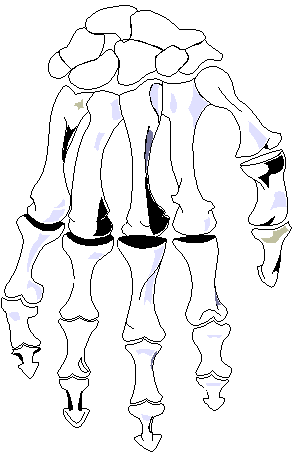Links
Page Navigation!
About This Page
This page consist of online training for EMS personnel. The subject of training is "The Skeletal System". To see more training topics, Click Here!
Bones are the main component of the skeletal system. They are capable of growth
and repair to certain limitations. Overall, the skeletal system is composed of about
206 bones. Bones are classified as long, short, flat, or irregular. The limbs
consist of long bones. The wrist and ankle are short bones. Certain skull bones, ribs,
scapulae, and the sternum are flat bones. The vertebrae and facial bones are
considered irregular bones. Three major types of bone are spongy, compact, and
subchondral bone. Spongy bone forms the ends of long bones and the interior of
others. It consists of interconnecting plates of bone that provide structural strength.
Spaces between the plates consist of red or yellow marrow(blood-forming cells or
fat cells). Compact bone is a very strong, solid matrix. It consists of osteocytes, or
bone cells, connected together by cell processes between thin sheets of matrix.
Nutrients are transferred to the osteocytes parallel along the long axis of the bone
within haversian canals, and diffuse to the osteocytes through the canaliculi (tiny
canals). Subchondral bone occurs in the articular surfaces underlying cartilage
at particular joints. It is characterized as unusually smooth and slightly shiny.
Subchondral bone contains an abundance of microscopic vascular canals piercing its
surface. These canals carry the blood vessels that provide nutrients to the deeper
parts of the hyaline cartilage. An average long bone has a long mid-section called
the shaft or diaphysis. At each end of the shaft there is an epiphysis or rounded part
covered by a protective articular cartilage. The remainder of the bone is covered by
connective tissue, or the periosteum. The periosteum contains nerves and blood
vessels. Within the shaft, there is a medullary cavity which consists of networks of
small cavities filled with yellow or red marrow.
Bone growth begins before birth and persists until adulthood. The skeleton begins
as fibrous membranes or cartilage models. These cartilage models are soon replaced
by osteoblasts, or bone-forming cells. Once the osteoblasts are fully surrounded by
bone matrix they become osteocytes. At birth, not all bone formation has taken
place. Some fontanels, or soft spots are left in the skull to allow movement of
skull bones during birth and allow growth of the head after birth. These soft
spots are converted to bone at about eighteen to twenty-four months of age.
Normal bone growth begins at the primary center of the bone, within the shaft and
epiphyses. The perichondrium, a special condensed mesenchymal tissue, is invaded
by many capillaries which change it into the periosteum. At the same time, the
central core of the bone is invaded by capillaries carrying osteoblasts and
osteoclasts, or large multinucleated cells that break down bone. These cells
degrade the calcified cartilage in a process called cavitation, leaving a narrow
cavity at the core of the bone. In this cavity, the osteoblasts lay down struts
and spicules of osteoid, which constitute the medullary center of ossification.
These struts calcify rapidly and fill most of the cavity. Calcification proceeds
outward from the medullary center and inward from the periosteal center
repetitively. The cartilage model is eventually replaced by bone. Finally, in
remodeling, the true medullary cavity is created and enlarged by resorption of the
bony struts and spicules previously laid down by the osteoblasts. The new cavity
becomes lined with a highly vascular membrane, or endosteum, which is capable of
providing osteoprogenitor cells for later remodeling. Once the shaft and epiphyses
are ossified, each skeletal element increases in size until maturity. This growth
involves both active resorption and deposition of bony material that changes the
bones length and width. While the overall diameter of the shaft wall increases,
so does the diameter of the medullary cavity. The periosteum and endosteum supply
osteoclasts and osteoblasts for resorption and production of bone. Size increase
begins prenatally and continues postnatally. Even after skeletal maturity is
reached, bone remodeling persists to accompany the appearance of new bone. This
process is triggered by stresses and injuries to the skeletal system. The
complex processes of bone growth and remodeling truly show the dynamic nature
of the skeleton.
Diagrams:
THE HEAD!
THE CHEST!
THE SPINE!
THE HAND!
THE ARM!
THE LEG!
FULL VIEW "FRONT"!
FULL VIEW SIDE!
SKELETAL AND MUSCLES!
Comments:
The skeletal system is quite complex. We hope the diagrams help with your studies of the skeletal system. Below are a couple of good links to further your knowledge of the Skeletal System. Take your time and browse the links, very good resources.
Skeletal System Links:
- The Skeletal System, no diagrams but good documentation. Click Here!
- The Human Skeletal System by Paula Brignac (excellent site)! Click Here!
- The Bone Zone. Nice site. Click Here!




















